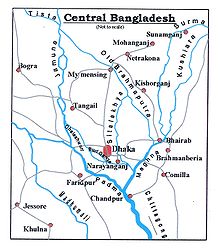Buriganga River
| Buriganga River | |
|---|---|
 A launch sails from Sadarghat on the Buriganga | |
 | |
| Native name | বুড়িগঙ্গা নদী (Bengali) |
| Location | |
| Country | Bangladesh |
| City | Dhaka |
| Physical characteristics | |
| Source | Dhaleshwari River |
| • location | near Kalatia |
| Mouth | Dhaleshwari River |
• location | about 3 km (2 mi) southwest of Fatullah |
| Length | 18 km (11 mi)[1] |
The Buriganga (Bengali: বুড়িগঙ্গা, Buŗigônga, lit. 'Old Ganges') is a river in Bangladesh which flows past the southwest outskirts of the capital city, Dhaka. Its average depth is 7.6 metres (25 ft) and its maximum depth is 18 metres (58 ft). It ranks among the most polluted rivers in the country.[2][3]
Importance
[edit]
The Buriganga is economically very important to Dhaka. Launches and country boats provide connection to other parts of Bangladesh, a largely riverine country.
Pollution
[edit]In the 20th century the water table and river became polluted by polyethene waste and other hazardous substances from demolished buildings near the river banks.
The Buriganga river now ranks among the most polluted rivers in the country.[2][3] The chemical waste of mills and factories, household waste, medical waste, sewage, dead animals, plastics, and oil are some of the Buriganga's many pollutants. The city of Dhaka discharges about 4,500 tons of solid waste every day, and most of it is released into the Buriganga.[4] According to the Bangladesh Department of Environment, 21,600 cubic metres (5.7 million US gallons) of toxic waste are released into the river by the tanneries every day.[5][6][7] Experts identified nine industrial areas in and around the capital city as the primary sources of river pollution: Tongi, Tejgaon, Hazaribagh, Tarabo, Narayanganj, Savar, Gazipur, Dhaka Export Processing Zone and Ghorashal. Most of the industrial units of these areas have no industrial wastewater treatment plants of their own.
According to the Dhaka Water and Sewerage Authority (WASA), about 12,000 cubic metres (420,000 cu ft) of untreated wastewater are released into the lake from Tejgaon, Badda and Mohakhali industrial areas every day. The wastewater mostly comes from garment washing and dyeing plants. Textile industries annually discharge as much as 56 million tonnes of waste and 0.5 million tonnes of sludge. Sewage is also released into the Buriganga.
Because of Dhaka's heavy reliance on river transport for goods, including food, the Buriganga receives especially high amounts of food waste since unusable or rotting portions of fruits, vegetables, and fish are thrown into the river.
History
[edit]
According to R. C. Majumdar, in the distant past, a course of the Ganges river probably used to reach the Bay of Bengal through the Dhaleshwari River. The Buriganga originated from the Dhaleshwari in the south of Savar, near Dhaka [8]
When the Mughals made Dhaka their capital in 1610, the banks of the Buriganga were already a prime location for trade. The river was also the city's main source of drinking water.
Gallery
[edit]-
Large launches waiting at Sadarghat on the Buriganga for different destinations in Bangladesh
-
A boatman sells pineapples at Sadarghat on the Buriganga
-
Sadarghat port on the Buriganga River, Dhaka city
-
Sadarghat port on the Buriganga river is an important river transport hub
-
Small boats ply on the Buriganga at Sadarghat
-
Land reclamation on the Buriganga river dredges sand and deposits it on the floodplain.
-
Evening of Buriganga River, Dhaka, Bangladesh
-
Sunset of Buriganga River
-
Launch
-
View of the Buriganga river at Sadarghat area with some launches
See also
[edit]References
[edit]- ^ "Burigunga River". Burigunga Riverkeeper. Archived from the original on 28 August 2013. Retrieved 13 October 2014.
- ^ a b Majumder, Azad (19 May 2009). "Bangladesh river pollution threatens millions". Reuters. Retrieved 9 January 2020.
- ^ a b "The river runs black: pollution from Bangladesh's tanneries – in pictures". the Guardian. 23 October 2015. Retrieved 9 January 2020.
- ^ Solid Waste Management In Dhaka City: Problems And Prospects
- ^ "Pollution control and tannery relocation". Leather International. Global Trade Media. 25 October 2002. Retrieved 22 February 2017.
- ^ "Toxic Tanneries: The Health Repercussions of Bangladesh's Hazaribagh Leather". Human Rights Watch. 8 October 2012. Retrieved 22 February 2017.
- ^ Aulakh, Raveena (12 October 2013). "Bangladesh's tanneries make the sweatshops look good". Toronto Star. Retrieved 22 February 2017.
- ^ Majumdar, R. C. (1971). History of Ancient Bengal. Calcutta: G. Bhardwaj & Co. p. 3. OCLC 961157849..
- ^ Bain, Marc. "Fast fashion is causing an "environmental emergency"". Quartz. Retrieved 9 January 2020.
- ^ Webber, Kathleen (22 March 2017). "How Fast Fashion Is Killing Rivers Worldwide". EcoWatch. Retrieved 9 January 2020.
- Chowdhury, Sifatul Quader (2012). "Buriganga River". In Islam, Sirajul; Jamal, Ahmed A. (eds.). Banglapedia: National Encyclopedia of Bangladesh (Second ed.). Asiatic Society of Bangladesh.










